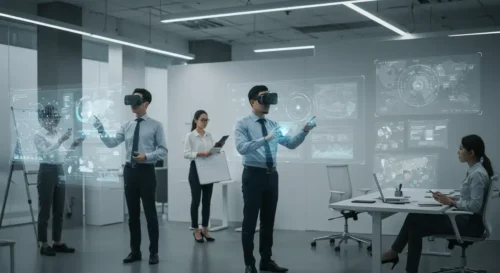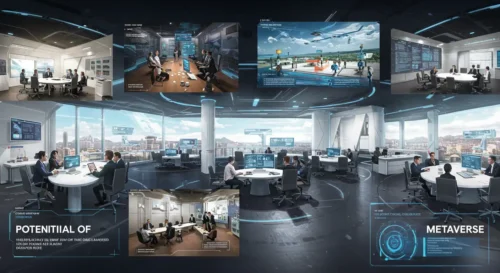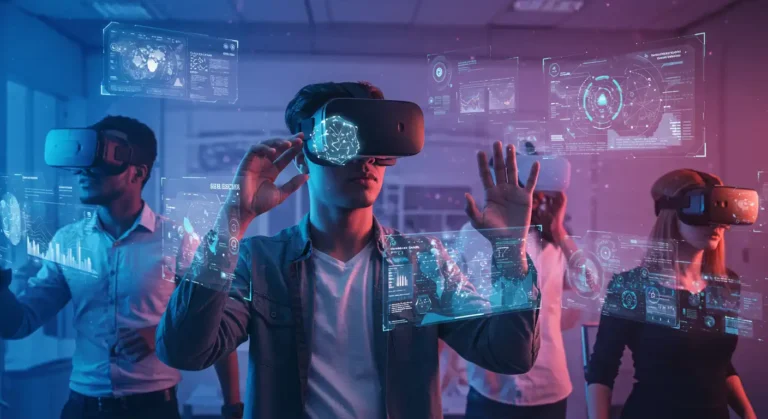The Metaverse Beyond Gaming: New Applications in Business and Education
I. Introduction:
Imagine stepping into a digital world where you can interact with others, attend meetings, explore ancient ruins, or even design a new product, all from the comfort of your own home. This is the promise of the metaverse – a persistent, shared, 3D virtual environment. While the term might evoke images of futuristic video games, the metaverse is rapidly evolving beyond entertainment, opening up exciting new avenues for businesses and educational institutions alike.
In fact, according to recent reports, the metaverse market is projected to reach trillions of dollars in the coming years, with companies like Nike already using virtual spaces to showcase new products and educational institutions exploring immersive learning experiences. But how did we get here, and what exactly does this mean for the future of business and education?
The concept of a metaverse isn’t entirely new. It first appeared in Neal Stephenson’s 1992 science fiction novel “Snow Crash,” where he envisioned a virtual world called the “Metaverse” where people could interact with each other as avatars. Over the decades, this idea has been explored in various forms of media, from movies like “Ready Player One” to online virtual worlds like Second Life. However, recent advancements in technologies like virtual reality (VR), augmented reality (AR), blockchain, and high-speed internet have brought the metaverse closer to reality than ever before.
Today, the metaverse is transitioning from a niche gaming phenomenon to a powerful tool with diverse applications. No longer confined to entertainment, it offers immersive and interactive experiences that can revolutionize how businesses operate and how students learn. This article will explore the exciting new applications of the metaverse in business and education, examining the opportunities, challenges, and the potential to reshape these crucial sectors.
II. Metaverse Applications in Business

The metaverse is rapidly transforming the business landscape, offering innovative ways for companies to operate, interact with customers, and develop new products and services. Here are some key applications:
Virtual Offices and Workspaces: The rise of remote work has highlighted the need for more engaging and collaborative online environments. The metaverse offers immersive virtual offices where employees can interact as avatars, attend meetings in realistic virtual conference rooms, and collaborate on projects in shared digital spaces. This can significantly improve communication, team cohesion, and overall productivity, especially for geographically dispersed teams. Companies like Accenture have created their own metaverse spaces for onboarding new employees and conducting internal training, demonstrating the potential for enhanced engagement and knowledge retention.
Training and Education: Traditional training methods can be costly and time-consuming. The metaverse provides opportunities for interactive simulations and virtual environments that offer practical, hands-on learning experiences without the risks and expenses associated with real-world scenarios. For example, medical professionals can practice complex surgeries in a virtual operating room, while engineers can test new designs in a simulated environment. Boeing uses VR training for aircraft maintenance, allowing technicians to practice procedures in a safe and controlled virtual setting.
Conferences and Events: Virtual conferences and events in the metaverse offer a more immersive and engaging experience compared to traditional video conferencing. Attendees can create avatars, network in virtual lobbies, attend presentations in virtual auditoriums, and even explore virtual exhibition halls. This can significantly reduce travel costs and logistical challenges, while also expanding accessibility to a global audience. PwC has used the metaverse for internal training and client events, showcasing the potential for enhanced engagement and networking opportunities.
Marketing and Advertising: The metaverse presents entirely new possibilities for marketing and advertising. Brands can create interactive virtual experiences, launch virtual products, and engage with customers in immersive ways. This can lead to greater brand awareness, customer engagement, and ultimately, increased sales. Nike has created its own virtual world called Nikeland within Roblox, allowing users to experience and purchase virtual Nike products. This innovative approach to marketing has proven highly successful in engaging younger audiences.
Virtual Products and Services: The metaverse allows businesses to create and sell digital goods and services that exist only in the virtual world. This includes virtual fashion items, digital art, virtual real estate, and more. The market for non-fungible tokens (NFTs) has further fueled this trend, enabling verifiable ownership and trading of digital assets. Meta (formerly Facebook) is heavily investing in the development of its metaverse platform, aiming to create a thriving digital economy where users can buy, sell, and trade virtual goods and services.
These examples demonstrate the vast potential of the metaverse to revolutionize various aspects of business operations. By providing immersive, interactive, and collaborative experiences, the metaverse is poised to transform how companies operate, interact with customers, and create value in the digital age.
III. Metaverse Applications in Education

The metaverse holds immense potential to revolutionize education by creating immersive, engaging, and accessible learning experiences. Here are some key applications:
Interactive Lessons and Learning: Traditional classroom settings can sometimes feel passive and unengaging for students. The metaverse offers the opportunity to create dynamic and interactive learning environments where students can actively participate in the learning process. Imagine learning about ancient Egypt by exploring a virtual pyramid, or studying the human body by dissecting a virtual heart. These immersive experiences can significantly enhance student engagement, understanding, and retention of information. For example, platforms like Engage offer virtual classrooms and learning environments where students can interact with each other and with instructors in a more engaging way than traditional video conferencing.
Virtual Excursions and Exploration: The metaverse can transport students to places and times that would be impossible to visit in the real world. Imagine taking a virtual field trip to the Amazon rainforest, exploring the surface of Mars, or witnessing historical events firsthand. These virtual excursions can bring history, science, and other subjects to life, making learning more exciting and memorable. Museums and cultural institutions are beginning to explore metaverse applications, creating virtual replicas of their collections and exhibits for educational purposes. For instance, some museums offer virtual tours that allow users to explore artifacts and exhibits from anywhere in the world.
Simulations and Practical Training: The metaverse provides a safe and controlled environment for students to develop practical skills through simulations and virtual training. This is particularly valuable in fields like medicine, engineering, and aviation, where real-world training can be expensive, dangerous, or impractical. Medical students can practice surgical procedures in a virtual operating room, while engineering students can test the strength of virtual bridges. This hands-on experience can significantly enhance learning outcomes and prepare students for real-world challenges. For example, several universities are using VR simulations to train nurses and other healthcare professionals in various medical procedures.
Accessibility of Education: The metaverse can help break down barriers to education for students with disabilities or those living in remote areas. Virtual learning environments can be customized to meet the individual needs of students with disabilities, providing a more inclusive and accessible learning experience. Furthermore, the metaverse can connect students from all over the world, fostering cross-cultural exchange and collaboration. Online universities and educational platforms are exploring the metaverse to create more immersive and engaging online learning experiences for students who cannot attend traditional brick-and-mortar institutions.
These examples illustrate how the metaverse can transform education by creating more engaging, interactive, and accessible learning experiences for students of all ages and backgrounds.
IV. Challenges and Considerations

While the metaverse offers a wealth of opportunities for business and education, it’s crucial to acknowledge the challenges and considerations that need to be addressed for its widespread adoption and successful implementation.
Cost and Accessibility of Technology: One of the primary barriers to entry is the cost associated with metaverse technologies. High-end VR headsets, powerful computers, and the development of immersive virtual environments can be expensive, making it difficult for smaller businesses and educational institutions with limited budgets to participate. Furthermore, the digital divide poses a significant challenge, as access to high-speed internet and necessary hardware is not evenly distributed globally. This can exacerbate existing inequalities and limit the potential for widespread metaverse adoption.
Technological Limitations: Despite significant advancements, metaverse technologies still face certain limitations. Bandwidth constraints can lead to lag and poor performance, especially in densely populated virtual environments. The quality of graphics and overall user experience can also vary significantly depending on the hardware and software used. Creating truly immersive and realistic virtual experiences requires further advancements in areas like haptics, motion tracking, and AI-powered avatars.
Security and Privacy: The metaverse generates vast amounts of user data, raising significant concerns about security and privacy. Protecting user identities, personal information, and financial transactions in virtual environments is crucial. Issues such as data breaches, identity theft, and online harassment need to be addressed with robust security measures and clear privacy policies. Furthermore, the decentralized nature of some metaverse platforms, based on blockchain technology, can present unique challenges for regulation and law enforcement.
Ethical Aspects: The metaverse raises a number of important ethical considerations. Concerns have been raised about the potential for addiction, social isolation, and the blurring of lines between the real and virtual worlds. The creation of realistic avatars and virtual identities can also lead to issues of misrepresentation and fraud. Furthermore, the metaverse’s potential impact on social interaction and real-world relationships needs careful consideration. Questions about accessibility, inclusivity, and the potential for creating echo chambers within virtual communities also need to be addressed.
Addressing these challenges is crucial for realizing the full potential of the metaverse in business and education. By focusing on affordability, technological advancements, robust security measures, and ethical guidelines, we can ensure that the metaverse becomes a positive and inclusive space for everyone.
V. Conclusion

The metaverse is rapidly evolving from a futuristic concept to a tangible reality with the potential to revolutionize various sectors, particularly business and education. As we’ve explored, the metaverse offers businesses unprecedented opportunities for remote collaboration, immersive training, innovative marketing, and the creation of entirely new virtual products and services. From virtual offices that enhance team communication to interactive simulations that provide practical training, the metaverse is transforming how businesses operate and interact with their customers.
In the realm of education, the metaverse promises to create more engaging and accessible learning experiences. Virtual field trips, interactive lessons, and realistic simulations can bring learning to life in ways that traditional methods simply cannot replicate. Moreover, the metaverse can break down geographical barriers and provide access to quality education for students from all backgrounds.
However, the path to widespread metaverse adoption is not without its challenges. Issues related to cost, technological limitations, security, privacy, and ethical considerations must be addressed to ensure that the metaverse becomes a positive and inclusive space for everyone. Overcoming these challenges will require collaboration between technology developers, businesses, educational institutions, and policymakers.
Looking to the future, the metaverse is poised to become an integral part of our lives, transforming how we work, learn, and interact with each other. As technologies like VR, AR, and AI continue to advance, we can expect to see even more innovative and immersive metaverse applications emerge. While the exact trajectory of its development remains to be seen, one thing is clear: the metaverse has the potential to reshape the future of business and education in profound ways.
VI. Frequently Asked Questions (FAQ)
Here are some frequently asked questions about the metaverse and its applications in business and education:
-
What are the main benefits of using the metaverse in business?
The metaverse offers several key benefits for businesses, including enhanced remote collaboration, more effective training programs, innovative marketing strategies, and the creation of new virtual products and services. It allows for more engaging customer interactions and opens up new revenue streams.
-
How can the metaverse improve education?
The metaverse can enhance education by creating immersive and interactive learning environments, providing virtual field trips and simulations, and making education more accessible to students with disabilities or those living in remote areas. It fosters a more engaging and personalized learning experience.
-
What are the biggest challenges of metaverse adoption?
Some of the biggest challenges include the cost of technology, technological limitations (such as bandwidth and graphics quality), security and privacy concerns, and ethical considerations related to social interaction and the blurring of real and virtual worlds.
-
Is the metaverse secure?
Security is a major concern in the metaverse. Protecting user data, identities, and financial transactions requires robust security measures and clear privacy policies. Ongoing efforts are being made to address these challenges, but users should be aware of potential risks.
-
What is the future of the metaverse in business and education?
The metaverse has the potential to transform both business and education significantly. We can expect to see more immersive and interactive applications emerge as technology advances. While challenges remain, the metaverse is likely to become an integral part of how we work, learn, and interact in the future.

